If you’ve ever filled a feeding station for your neighborhood cats only to find a masked bandit finishing off the last kibble, you know the frustration. Raccoons are clever, persistent, and always hungry. Feeding feral cats is one of the most direct ways you can help them thrive, but it only works when the food actually reaches the cats you’re trying to support.
Here’s the good news: cats and raccoons move differently, think differently, and respond to different triggers. These eight secrets use those differences to create a feeding station that works like a VIP club—cats get in easily, raccoons stay out.
1. The Platform Height Sweet Spot That Raccoons Hate
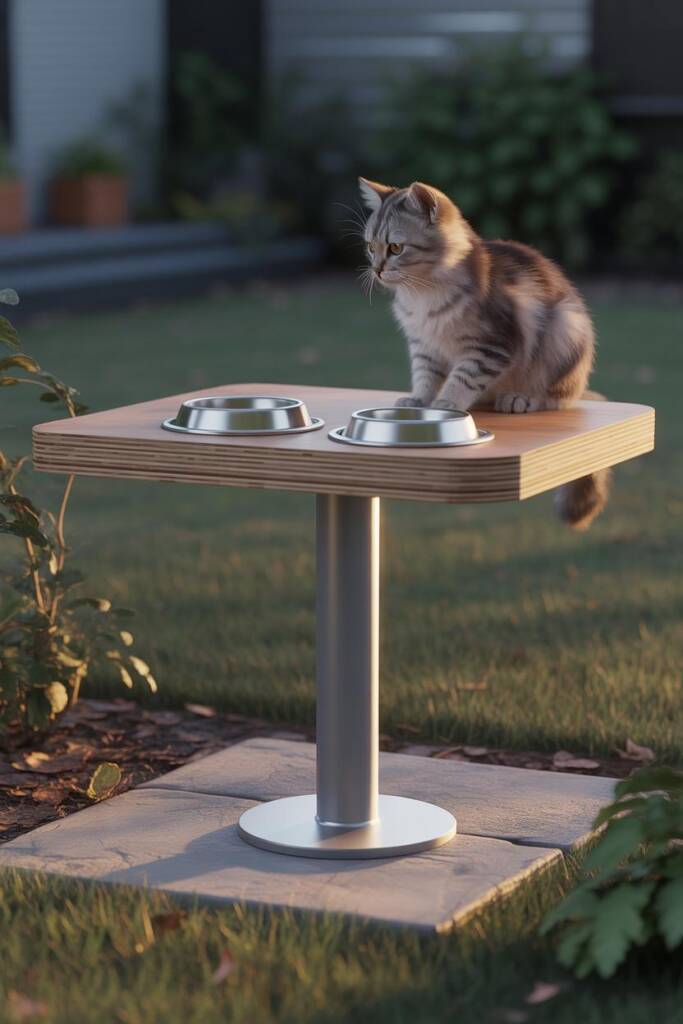
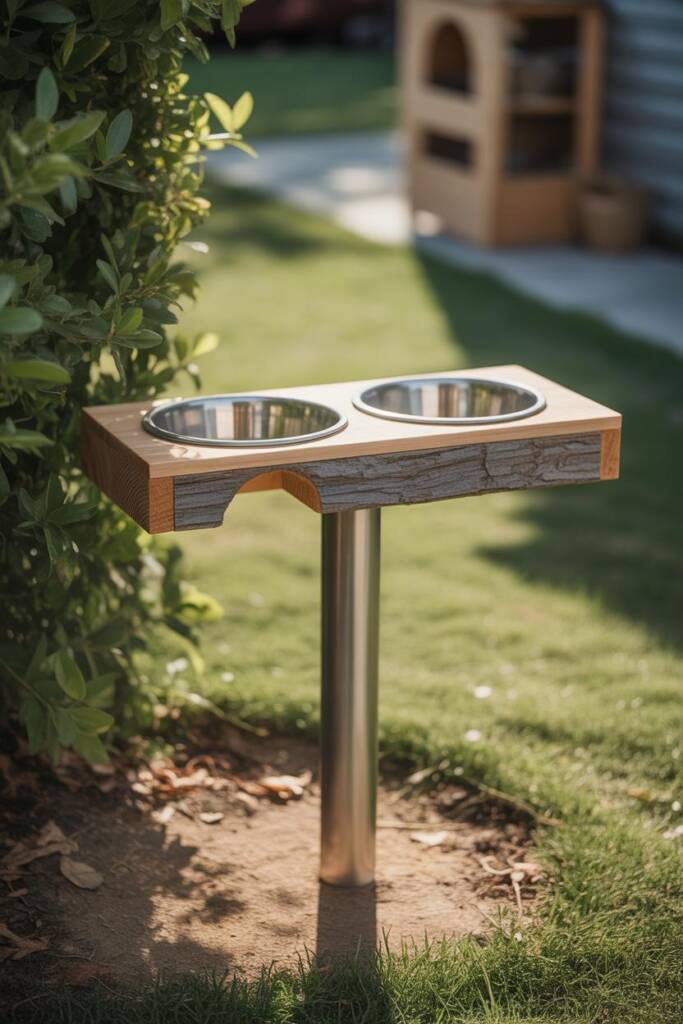
Why Most Feeding Stations Fail at Ground Level
Ground-level feeding stations are an open invitation to every creature in the neighborhood. Raccoons are opportunistic feeders, and if food is easy to reach, they’ll claim it as theirs. The secret isn’t just elevation—it’s finding the exact height where cats excel and raccoons struggle.
The Magic Height Range
Build your feeding platform between 18 to 24 inches off the ground with a narrow access point. Cats are natural jumpers with incredible agility. They can effortlessly leap onto this platform from a standing position. Raccoons, however, are climbers, not jumpers. Their heavier body weight (12-35 pounds compared to a cat’s 8-10 pounds) and body structure make them rely on climbing rather than vertical leaping.
How to Build Your Elevated Station
Use a sturdy wooden platform or repurpose a small outdoor table. The key is making the access point narrow—about 6-8 inches wide. Attach it to a smooth pole or create a single access ramp that’s only wide enough for a cat. Remove any nearby structures raccoons could use as a launching pad. Add a small lip around the edges to prevent bowls from sliding off.
The Game-Changing Detail
Sand down the support pole and coat it with a slick finish like paste wax or smooth PVC piping. Raccoons need grip to climb, and a slippery surface becomes an insurmountable obstacle. Your cats will simply jump up and bypass the problem entirely.
2. The Timing Window Trick That Beats Their Schedule
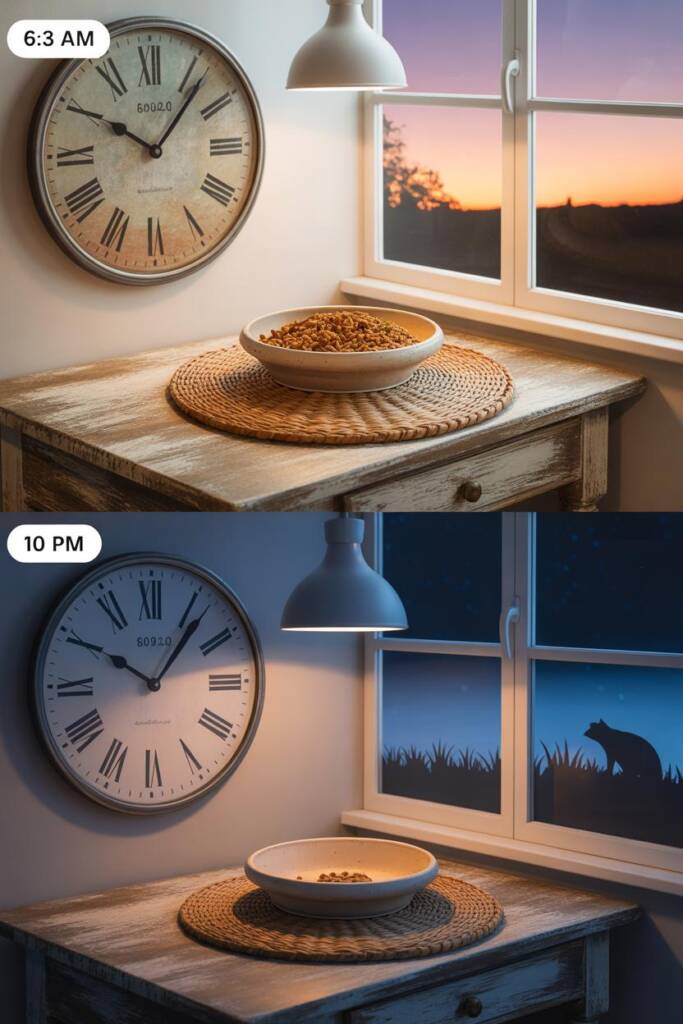
Understanding the Activity Gap
Raccoons and cats are both most active at night, but their peak hours don’t completely overlap. This creates a golden window of opportunity that most people never exploit. Cats are crepuscular—they’re most active during dawn and dusk. Raccoons typically start their evening rounds later, usually after 10 PM, and they’re creatures of habit.
The Two-Hour Feeding Window
Feed your colony cats during their natural feeding times: early morning (6-8 AM) or early evening (5-7 PM). Stay present during feeding time or set a timer to return. Remove all food after exactly two hours. No exceptions, no leftovers.
Why This Works Better Than You Think
Raccoons are intelligent enough to learn schedules. If they consistently arrive at a location and find nothing, they’ll eventually stop wasting energy checking that spot. It takes about two to three weeks of consistency, but raccoons will reclassify your feeding station as “unreliable” and focus their attention elsewhere.
The Training Period
Your cats will adjust within days—they’re already naturally inclined to eat during these windows. The first two weeks are critical. Raccoons will still check, find nothing, and slowly lose interest. Mark your calendar and commit to the schedule. This method requires discipline, but it’s one of the most effective long-term solutions that doesn’t require expensive equipment.
3. The Weighted Lid System Only Cat Paws Can Open
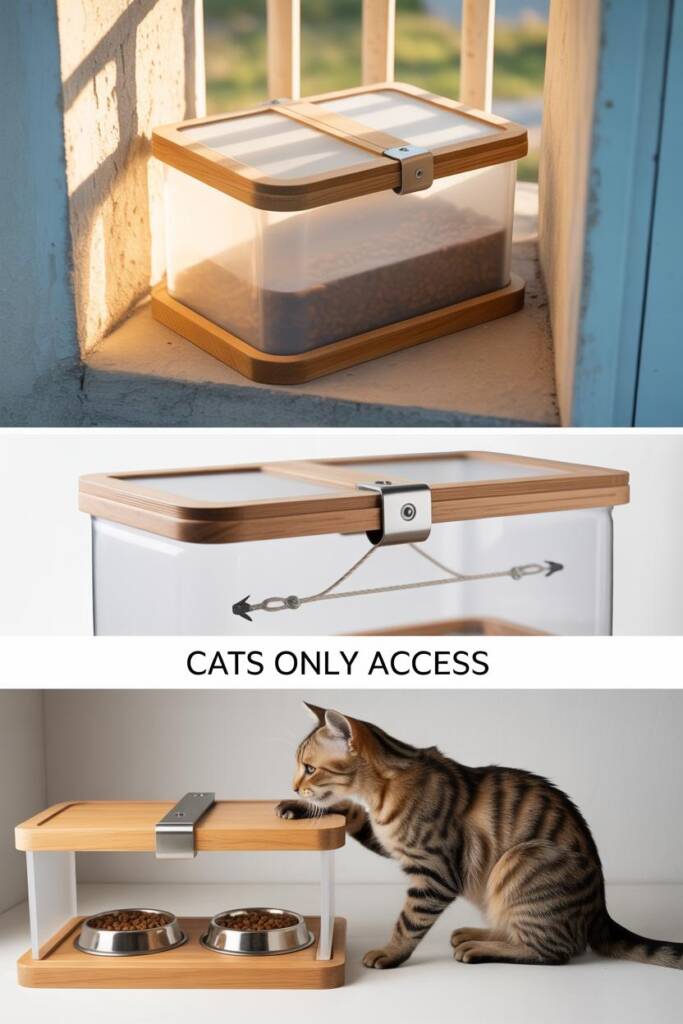
The Physics Behind Selective Access
Cats typically weigh 8-10 pounds and distribute their weight on four small paws. Raccoons weigh significantly more and have broader, flatter paws. This difference creates an opportunity for a pressure-sensitive feeding system that responds to weight and weight distribution patterns.
Building Your Pressure-Sensitive Feeder
Start with a sturdy plastic storage container with a hinged lid. Cut an opening large enough for a cat to enter (about 6×6 inches). Create a hinged flap over this opening using lightweight plastic or thin plexiglass. Attach the flap at the top with small hinges, and add a counterweight system using a bungee cord or light spring underneath that keeps the door closed.
The trick is calibration: the door should open when a cat steps on a small platform in front of it (their concentrated weight on the platform triggers the release) but remain closed when pushed or pawed at from the outside. Raccoons will try to manipulate it with their hands, but without the stepping motion that creates the right pressure point, the door stays shut.
Fine-Tuning Your System
Test the sensitivity with different cats in your colony. Smaller cats should still be able to trigger it. You might need to adjust the spring tension or counterweight over the first few days. Once dialed in, this system becomes almost foolproof. Cats learn the stepping motion within one or two feeding sessions—they’re remarkably quick learners when food is involved.
4. The Maze Entry That Confuses Raccoon Hands
Why Raccoon Dexterity Becomes Their Weakness
Raccoons are famous for their hand-like paws that can open jars, unlatch gates, and manipulate objects. But this dexterity comes with a limitation: they need to see and reach what they’re manipulating. Cats, on the other hand, are flexible contortionists who navigate by feel and can twist their bodies through complex spaces without using their paws to problem-solve.
Designing the Perfect Maze Entry
Create an entry path with two 90-degree turns in opposite directions—think of an S-curve or Z-pattern. The passages should be 5-6 inches wide and about 12 inches long between turns. Build this using wood, PVC pipes, or sturdy cardboard covered in weatherproof material. The entry should be elevated slightly (even 6 inches helps) and requires the animal to commit their whole body to navigate it.
Cats will walk through this confidently after one or two attempts. They’re comfortable moving through tunnels and tight spaces—it’s instinctive. Raccoons, however, want to reach in with their paws first, assess the situation, and manipulate their way through. The blind turns and the need to fully commit their body without knowing what’s around the corner goes against their cautious, hands-first approach.
The Critical Measurements
Keep the passage width between 5-6 inches—wide enough for cats but tight enough that a raccoon can’t comfortably maneuver. The turns should be sharp 90-degree angles, not gradual curves. Gradual curves are too easy. Add a roof to the maze so raccoons can’t reach over the top. Paint or line the interior with a slightly rough texture so cats have good traction, but not rough enough for raccoons to grip and pull themselves through.
5. The Scent Barrier Raccoons Won’t Cross
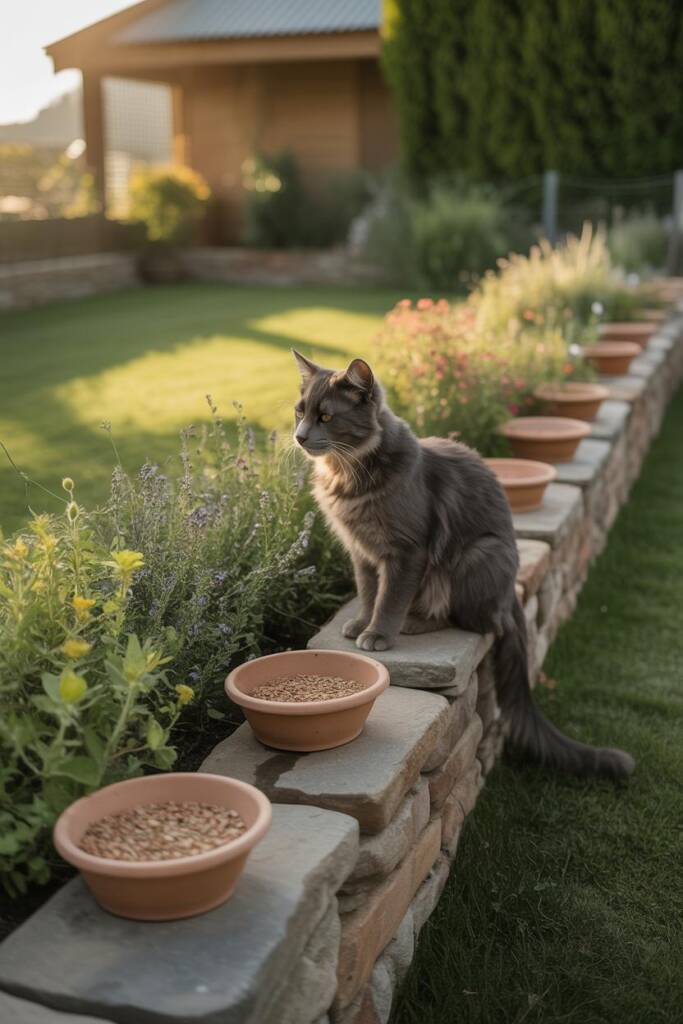
Understanding Territorial Instincts vs Familiarity
Raccoons are territorial creatures who rely heavily on their sense of smell to assess risk and reward. They’ll avoid areas that signal danger or the presence of predators. Cats, especially colony cats, become familiar with their feeding area and will push past mild deterrents when they know safety and food await them on the other side. This difference in risk assessment creates an invisible barrier you can use strategically.
Creating the Perimeter Without Affecting Cats
The key is placement—never apply deterrents directly at the feeding station. Instead, create a scent perimeter 3-4 feet around the station along the most common raccoon approach paths. Use ammonia-soaked cotton balls placed in small, weighted containers (like film canisters with holes punched in them). Ammonia mimics the smell of predator urine, which signals danger to raccoons.
Alternatively, use commercially available predator urine granules (coyote or fox) scattered in a broken line around your station. Raccoons interpret this as an active predator territory and typically won’t risk crossing it. Your cats, who enter from a specific direction and are already comfortable with the area, will walk right through because they’ve learned this space is safe.
The Application Strategy That Works
Apply deterrents in the evening before raccoon activity peaks, and refresh them every 3-4 days or after rain. Focus on the pathways raccoons use—near garbage areas, along fence lines, or from wooded areas. Leave your cats’ preferred approach path clear or use minimal deterrent there. Within a week, raccoons will reroute their nightly travels away from your feeding zone.
What Never to Use
Avoid mothballs (toxic to cats), cayenne pepper (can harm cats’ respiratory systems), or anything with a strong scent that lingers at the feeding area itself. The goal is to create an invisible fence raccoons respect while cats barely notice. Keep the feeding zone itself neutral and welcoming for your colony.
6. The Bungee Cord Door Cats Master in Minutes
Why Resistance-Based Entry Beats Latches
Raccoons are problem solvers who excel at manipulating rigid mechanisms—latches, locks, and levers. But they’re surprisingly deterred by resistance they can’t problem-solve their way around. A bungee cord door creates constant, flexible resistance that requires commitment and force rather than clever manipulation. Cats, being more impulsive and food-motivated, simply push through without overthinking it.
Building Your Flexible Entry Door
Cut a cat-sized opening (7×7 inches) in your feeding station. Create a door flap using thick rubber mat material or heavy-duty vinyl—something flexible but substantial. Attach two small bungee cords to the top corners of the flap and secure them to the inside top of the feeding station, creating tension that pulls the door closed.
The tension should be firm enough that it requires a deliberate push to open, but not so tight that smaller cats struggle. When a cat pushes against it, they can use their whole body weight and momentum to enter. Once inside, the door snaps shut behind them.
The Learning Curve Advantage
Cats figure this out incredibly fast—usually within their first or second attempt. They’re motivated by food and don’t mind the sensation of pushing through something. Raccoons, however, want to paw at it, lift it, or find a way to hold it open while they assess what’s inside. The constant resistance frustrates this approach. They’ll paw at it a few times, but without the immediate reward of easy access, they typically move on to easier targets.
Adjusting for Your Colony
Test with your shyest or smallest cat first. If they struggle, reduce the bungee tension slightly. Mark the position once you find the sweet spot. You can also add a treat just inside the entrance during the first few days to encourage cats to push through confidently. Once they learn the motion, they’ll push through without hesitation every single time.
7. The Motion-Activated Water Defense System

Why Water Works When Nothing Else Does
Raccoons hate unexpected water sprays. Unlike many other deterrents they can adapt to, a sudden blast of water triggers an instinctive retreat response. The beauty of this system is precision—you can protect raccoon approach paths while keeping your cats’ entry route completely dry.
Strategic Positioning Makes All the Difference
Install a solar-powered motion-activated sprinkler positioned to cover the primary raccoon approach zones—typically from wooded areas, garbage zones, or along fence lines. The critical detail is angling: position it so the spray zone covers where raccoons would approach from, but leaves a clear, dry pathway for your cats’ preferred entry route.
Study your cats’ patterns for a few days. They likely approach from one or two consistent directions. Keep those paths outside the motion sensor’s range. Raccoons, being larger and less cautious, will trigger the sensor from farther away and get sprayed before they reach the feeding area.
Calibration for Success
Most motion sprinklers have adjustable sensitivity and spray duration settings. Set the sensitivity high enough to catch raccoons but position it so cats walking close to the feeding station (within 6-8 feet) don’t trigger it. Set spray duration to 3-5 seconds—enough to startle and deter, but not so long that it wastes water or becomes a constant disturbance.
The Conditioning Effect
After just a few nights of getting sprayed, raccoons learn to avoid that entire area. They’re smart enough to remember locations where unpleasant surprises happen. Meanwhile, your cats happily eat their meals in the dry zone, completely unbothered. Solar power means no wiring, and most models work for months on a single charge.
8. The Decoy Station Strategy That Redirects the Problem

Working With Raccoon Behavior Instead of Against It
Here’s the counterintuitive secret most people never consider: sometimes the best defense is strategic offense. Instead of trying to make your feeding area 100% impenetrable, give raccoons what they want—just not where you want your cats to eat. This double-station approach uses psychology rather than barriers.
Setting Up Your Sacrificial Station
Place a second feeding station 15-20 feet away from your main cat feeding area, positioned along the raccoons’ natural approach path. Stock it with less desirable but still appealing food—basic dry dog food, stale bread, or overripe fruit. Nothing expensive, nothing premium. This becomes the raccoon station.
Your main station gets the good stuff—quality cat food, wet food if you’re using it, and all the features from the previous seven secrets. Position the decoy station so raccoons encounter it first on their nightly route. Most will stop at the easy food source and won’t bother investigating further, especially if the main station is elevated, has maze entries, or other deterrents.
Why This Works Better Than You’d Expect
Raccoons are opportunistic and efficient. If they find adequate food without effort, they’ll take it and move on to the next part of their territory. They’re not vindictive—they’re just hungry. By satisfying that hunger with minimal effort, you’re essentially paying a small food tax to protect your main investment in colony cat care.
The decoy station also serves another purpose: it keeps raccoons visible and predictable. You’ll know exactly where they’re feeding, which helps you monitor the situation and adjust your strategy if needed.
Managing the Decoy System
Put out small amounts of decoy food—enough to interest raccoons but not so much that you’re creating a raccoon buffet that attracts more animals. Refresh it only every other day or when you notice it’s been cleared. This keeps raccoons interested but not dependent. Meanwhile, your main cat station operates on its tight feeding schedule with all your protective measures in place, remaining a cat-only zone.
Shopping List to Make These Ideas Work
Having the right supplies on hand makes building your raccoon-proof station faster and easier. Here are the essentials that’ll help you implement these secrets effectively:
- Solar Motion-Activated Sprinkler – The workhorse of outdoor deterrents, these sprinklers cover up to 1,200 square feet and run for months without needing new batteries. Look for models with adjustable sensitivity so you can fine-tune the detection range for raccoons while keeping your cats’ pathway dry.
- Heavy-Duty Bungee Cords (Various Sizes) – You’ll use these for creating tension doors and securing components that need flexible resistance. Get a multi-pack with different lengths and thicknesses so you can adjust tension based on your cats’ sizes and strength levels.
- Weatherproof Storage Container with Hinged Lid – A 20-30 gallon container becomes the foundation for multiple strategies—the weighted lid system, maze entries, and protected feeding zones. Choose one with a secure but modifiable lid that you can cut and customize without cracking.
- Predator Urine Granules or Ammonia – These create your invisible scent barrier without chemicals that harm cats. Predator urine granules last longer in outdoor conditions, while ammonia is budget-friendly and effective when refreshed regularly. Both signal danger to raccoons while remaining safe for your colony cats.
- PVC Pipes or Smooth Wooden Posts – Essential for building elevated platforms that raccoons can’t climb. PVC is naturally slick and weather-resistant, while wooden posts can be sanded smooth and treated with paste wax for the same effect. Get 4-6 feet lengths so you have flexibility in your platform height and design.
Making Your Raccoon-Proof Feeding Station a Reality
Your neighborhood cats deserve a safe, reliable place to eat without competing with masked bandits. These eight secrets work because they’re based on real behavioral and physical differences between cats and raccoons. The best part? You don’t need all eight—even combining two or three of these strategies will dramatically improve your success rate. Start with the methods that fit your budget and setup, then add more layers of protection as needed.
At Sweet Purrfections, we’re all about clever solutions that make life better for the pets and homes we love. Whether you’re caring for a colony of community cats or just trying to feed your own outdoor cats without feeding the whole neighborhood, small strategic changes create big results.
Meet Sean, a fintech whiz with a penchant for pet purrs and blockchain buzz. After a decade of fintech feats, Sean’s tech talents leaped from ledger lines to litter lines, driven by a passion for pets and a vision for a more connected pet care community. With three critter companions as co-pilots, Sean launched this blog to share a treasury of pet-friendly tech tips and tales.



Leave a Reply